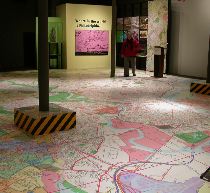 It seemed so off the beaten First Friday path that we didn’t think we’d make it to the opening, but, by George, the Atwater Kent Museum on 7th St. is directly up the block from The Optimistic so we tumbled in to see Kocot and Hatton‘s video, “Flag” and to check out the new floor map installation “Where in the world is Philadelphia.”(shown)
It seemed so off the beaten First Friday path that we didn’t think we’d make it to the opening, but, by George, the Atwater Kent Museum on 7th St. is directly up the block from The Optimistic so we tumbled in to see Kocot and Hatton‘s video, “Flag” and to check out the new floor map installation “Where in the world is Philadelphia.”(shown)Kocot and Hatton, the conceptual collaborators whose work appears at Larry Becker Gallery and elsewhere had previously written to tell us of their inclusion in the AK show. Their video “Flag” captures an inky black night and a flag snapping in the wind. The 41-minute-long piece, on view in a small room off the lobby, displays mostly dark night. But when the flag whips into view — spotlit by a stationary floodlight — it becomes an eerie spectre, alive and seemingly reaching out. (shown)
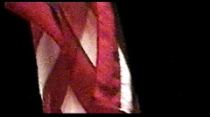
Libby told you about a previous K&H’s video of a dark and stormy night (read). This piece, like that one, captures real time action (or inaction) and by sheer weight of time passing creates an elegaic work that turns something prosaic into a monument. Warhol, with his 12-hour long films of the Empire State Building or a person sleeping, did it first, but K&H with their own poetic vision, have created a great, slow piece for fast times.
Speaking of fast times
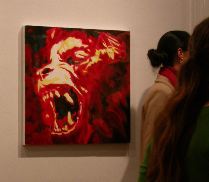 As Libby told you, we met at The Optimistic on Washington Square for the painting salon. As we talked about blue state secession from the country with the Optimistic’s proprietor, Jeff McMahon and with Samuel Yun and Matt Sepielli, the gallery space filled up with viewers and the atmosphere — homey and warm — was terrific for looking at art.
As Libby told you, we met at The Optimistic on Washington Square for the painting salon. As we talked about blue state secession from the country with the Optimistic’s proprietor, Jeff McMahon and with Samuel Yun and Matt Sepielli, the gallery space filled up with viewers and the atmosphere — homey and warm — was terrific for looking at art.
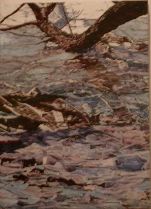
Amidst the abstract, process and narrative works, I found the photo-influenced works the most fun. It’s possible I was only reacting to the photo source material — a werewolf (by Eric Swartz, shown), praying altarboys (not shown), a tree limb over water (by Michael Sullivan, shown).
It’s easy enough to conflate your reaction to source material with your reaction to the work itself. That’s neither a bad nor a good thing and it depends on the final product how the art hangs together. Here, I admired Swartz’s and Sullivan’s admittedly very different painting styles and their ability to create extremes of hot and cool imagery and deal with death and symbolism and feel contemporary and old at the same time.
Twins Seven-Seven at Indigo
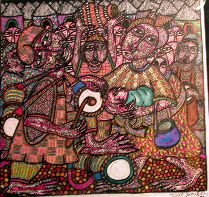
The Nigerian-born artist Twins Seven-Seven, whose work is included in the African Art, African Voices show at the PMA (see Libby’s post), has four works on view at Indigo Arts in that gallery’s “African Visions” exhibit.
Seven-Seven, (born Taiwo Olaniyi Salau) who now lives in the Philadelphia area, came to art via music, according to Indigo’s Tony Fisher, who’s been exhibiting the artist’s work for around ten years.
The artist, who christened himself “Twins Seven-Seven” to refer to his lineage — he’s the sole survivor of a line of seven sets of twins — was a travelling troubadour when he came to an arts-heavy village, Oshogbo, in 1964 and found a home there — and discovered his gift for visual art.
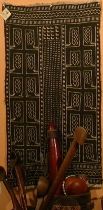
The artist’s imagery, based in his Yoruba cultural practices (image above righ is “Baby Naming Ceremony”), presents a world where real and mystical combine in a fluid atmosphere that seems inherent in much aboriginal art. My picture hardly does his work justice. The details-heavy world created by the artist is one you can fall into and get lost in
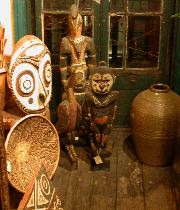
And surrounding the artist’s work is a treasure trove of cloth, carvings and signage from African countries.
The mud cloth by Nakunte Diarra (image above) is a stand-out as are the carved figures in general (image right).
That’s it for now. I’m off to see Teresa Jaynes‘ installation at Abington Art Center.









